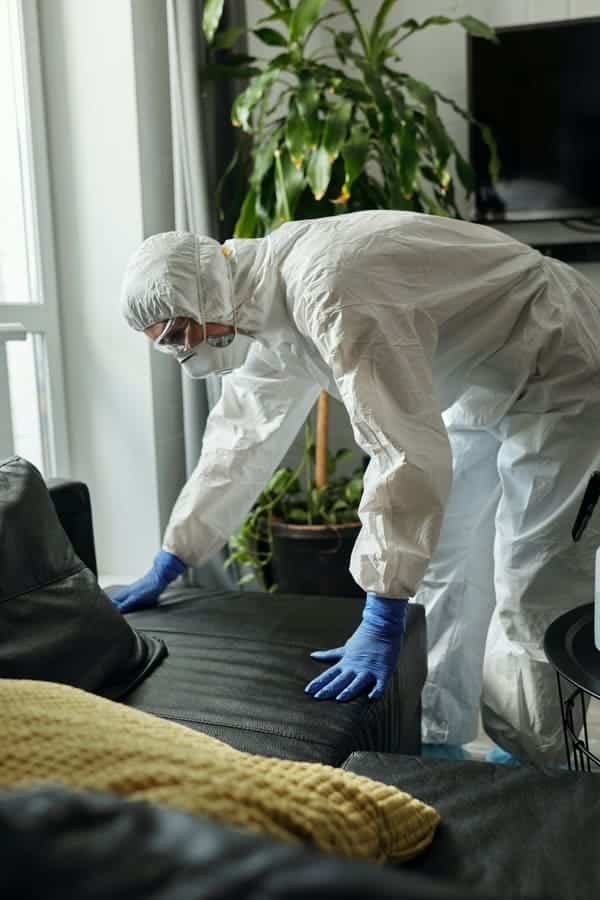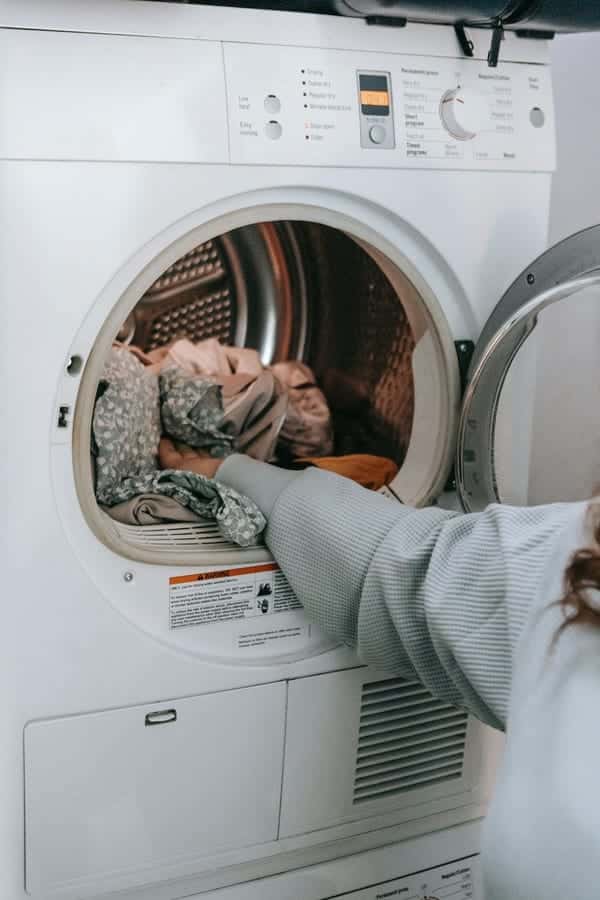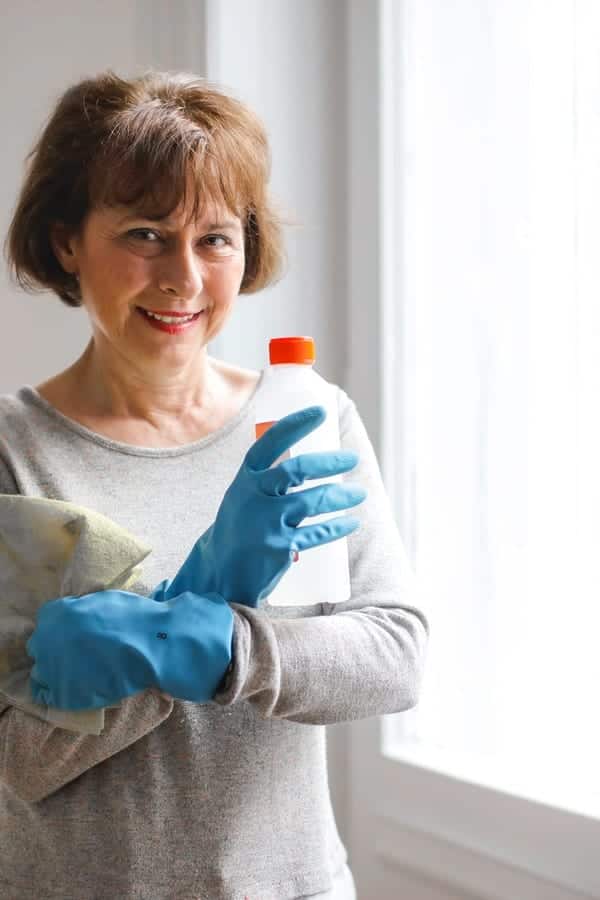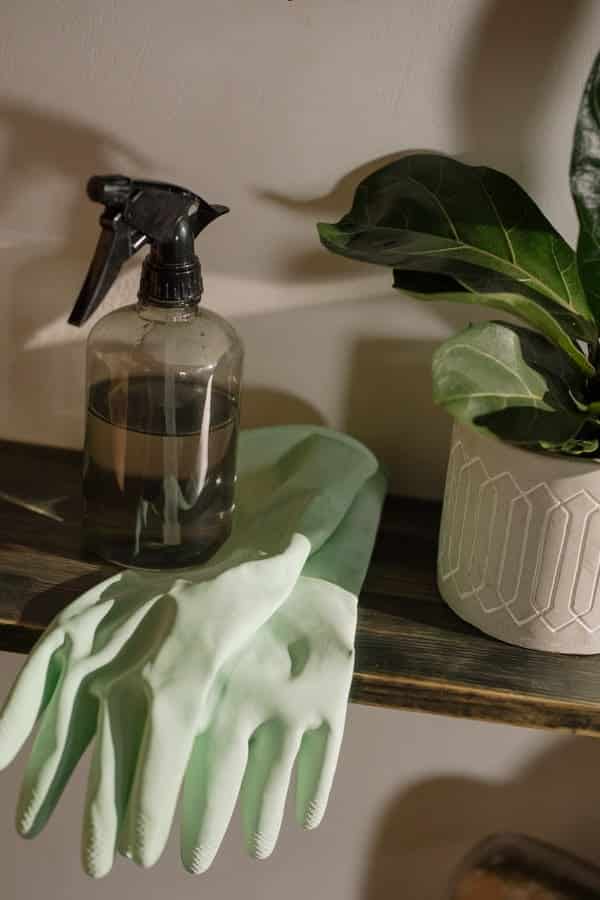Hydrogen peroxide has long been a favorite cleaner in many households. That’s because it has a wide variety of applications.
In the kitchen, it can be used to clean your dishwasher, sink, countertops, and more. In the bathroom, it’s equally effective at whitening the surfaces, as well as eliminating mold and mildew.
When it comes to laundry, hydrogen peroxide is more popular than bleach. We will explain what makes it a better option than chemical bleach.
Also, you will learn how to use hydrogen peroxide without ruining your clothes or fabrics.
- Hydrogen peroxide vs. bleach
- What is hydrogen peroxide?
- Be careful with hydrogen peroxide
- Removing stains with hydrogen peroxide
- Spot testing
- Using hydrogen peroxide with your laundry
- Getting rid of the yellow stains
- What strength of hydrogen peroxide is best for stain removal?
- Don’t mix hydrogen peroxide with these
- Keep hydrogen peroxide in the dark
- Hydrogen peroxide should be in your home
There may be affiliate links in this article. You can read more about this in my disclosure.
Hydrogen peroxide vs. bleach
Bleach is a must-have for a lot of homes. Its oxidizing properties make it effective at eliminating germs and bacteria.
This same property gives bleach the power to remove the color from surfaces and fabrics.
However, bleach can irritate the skin and eyes. If you have sensitive skin, you might have reactions.
Also, bleach can cause the fabric to have a yellowish tinge over time. If you aren’t a fan of bleach, hydrogen peroxide is a suitable alternative.
[amazon box=”B074H81LY5,B07J6FJR8D” grid=”2″]What is hydrogen peroxide?
Hydrogen peroxide is simply water with an extra molecule of oxygen added to it. That might seem like it isn’t much, but the additional oxygen element is what gives hydrogen peroxide its cleaning ability.
As an oxidizing agent, it is much safer than bleach. So, you get similar cleaning results with hydrogen peroxide as you would with bleach, minus the irritation.
However, hydrogen peroxide does have a weak point. It is highly reactive, which means that it won’t hold its results for very long.
This equates to you having to reapply hydrogen peroxide more often than you would if you used bleach.
Okay, enough of comparing hydrogen peroxide with bleach. Let’s show you how you can use it on your clothes.
Be careful with hydrogen peroxide

We begin with a warning: give hydrogen peroxide the same level of respect you would give standard bleach.
It is possible that being careless with your hydrogen peroxide can cause irreparable damage to your clothes. So, use caution.
With that vital announcement over and done with, it’s time to learn how to add hydrogen peroxide safely to your laundry.
Removing stains with hydrogen peroxide
Busting stains with hydrogen peroxide is relatively simple.
- Screw on a spray attachment to the bottle of hydrogen peroxide. Spray over the stain
- Let the hydrogen peroxide seep into the stain for 10 minutes
- Place your clothing into the washing machine and give it a wash
Spot testing
If you are going to use hydrogen peroxide on colored clothing, then test to see if the color will run.
Take a cotton swab and dip it into your hydrogen peroxide. Dap the swab onto a discrete piece of the fabric.
If you find that the color is transferred onto the cotton swab, then you have a problem.
The best option for you in this situation is to look into a different method for removing the stain.
Using hydrogen peroxide with your laundry

You can make your whites whiter and your colors more vivid with hydrogen peroxide. Place a cup of hydrogen peroxide into the bleach dispenser of your washing machine.
If your machine doesn’t have this type of dispenser, you can premix a solution: add two cups of water to one cup of hydrogen peroxide. Pour your solution into the washing machine before you put in your load of washing.
You can also add it in once the machine has filled with water.
Remember to make sure that your clothes are colorfast. Not doing so can cause a laundry disaster!
Getting rid of the yellow stains
You may find that as you regularly use hydrogen peroxide, your clothes take on a yellowish tinge. Don’t feel like you have to toss your beloved clothes away.
It is possible to rescue them with some vinegar and water.
However, time is of the essence. So, act immediately when you spot that yellow stain.
Round up the following items:
- A bucket
- A bowl
- Cold water
- White vinegar
- A cloth
- A hard-bristled brush
- Dish soap
Once you have your equipment ready, it’s time to proceed.
- Fill your bucket with cold water.
- Dip your clothing into the water.
- Pour a tablespoon of vinegar into the bowl.
- Take your cloth and dip a corner of it into the vinegar.
- Pat the stain with the vinegar, then wait 5 minutes.
- Wash out your clothes with water.
- Pour several drops of dish soap onto the yellow stain.
- Grab your brush and give the stain a good scrub. Don’t get too harsh as you will end up damaging the fabric.
- Give your clothing a cycle in your washing machine.
Another option is to use commercial bleach instead of vinegar.
If you want to try this, swap out the vinegar with a ¼ teaspoon of bleach mixed with ½ a cup of water. Then proceed with steps 4–9 above.
What strength of hydrogen peroxide is best for stain removal?

You will find that hydrogen peroxide comes in different strengths.
- 3% is suited for typical household use
- 10% concentration is used for bleaching hair
- 35% strength is considered food grade
- 90% concentration is industrial strength
For stain removal, which level of hydrogen peroxide will tackle the job? Most people will tell you that 3% concentration isn’t powerful enough to remove stains.
Going higher than 50% strength will bleach your clothes, leaving you with a heartbreaking situation.
The recommended level for effectively treating stains is 10%.
Don’t mix hydrogen peroxide with these
We want you to remain safe and healthy while tackling stains. Hydrogen peroxide is safe on its own.
But, if you mix it with some other compounds, it can become a health hazard.
Vinegar
Because vinegar is acetic acid, adding hydrogen peroxide to it can create peracetic acid. You will find it gives off a strong vinegary odor.
As a cleaning solution, it isn’t effective as the strength has been reduced. You will find yourself getting frustrated over the result.
Additionally, peracetic acid can irritate your eyes, nose, skin, and throat. It can also affect your lungs.
[amazon box=”B000RO08L0″ template=”vertical”]Chlorine Bleach
You may be tempted to use bleach with hydrogen peroxide. After all, the thinking goes that both are effective stain removers, so why not double the impact?
The reality is that you will be reducing the strength of the hydrogen peroxide. That is because chlorine bleach is more powerful and dilutes hydrogen peroxide.
So you aren’t getting any real benefit from the peroxide.
Another issue is that mixing chlorine bleach with hydrogen peroxide makes oxygen gas. That may seem amazing, but it is highly flammable and dangerous.
[amazon box=”B07J6FJR8D” template=”vertical”]Ammonia
When you mix bleach (which hydrogen peroxide is) with ammonia, you will create chloramine. This is a gas that results in health issues similar to those experienced if you mix hydrogen peroxide with vinegar.
Chloramine can cause coughing, burning of the throat, breathing difficulties, and chest pains.
[amazon box=”B01KEJPKCE” template=”vertical”]Keep hydrogen peroxide in the dark
Hydrogen peroxide doesn’t like light that much. It is usually found in brown, opaque bottles.
You will also spot it for sale in other styles of containers.
However, all the bottles share one thing in common: they stop the light from getting to the hydrogen peroxide inside.
Hydrogen peroxide is highly reactive. Exposure to light can start to cause it to decompose, which renders it useless.
That means, extending the life of hydrogen peroxide requires you to keep it in its original bottle. Storing the bottle somewhere dark adds a little more protection.

Hydrogen peroxide should be in your home
Hydrogen peroxide isn’t anything new. It was discovered in 1818 by a professor at the Collège de France, Louis Jacques Thénard.
Since its discovery, hydrogen peroxide has come to be used in a variety of ways:
- As an antiseptic, it can clean and protect wounds
- You can use it as a mouthwash.
- General bleach for removing germs and bacteria from household surfaces
As we have seen, you can also use it to get rid of stains from clothing and fabric. Yet, you need to treat hydrogen peroxide with care.
Too much of it can leave you lamenting your ruined clothes.
Test a small patch of colored clothing before proceeding with adding hydrogen peroxide to your laundry.
Avoid mixing vinegar, chlorine bleach, or ammonia with hydrogen peroxide. Doing so creates gases that can be harmful to your health.
Like anything you use for cleaning, carefully read the instructions on how to use hydrogen peroxide. Experiment with lower strengths, slowly building up to higher levels of concentration.
Then you will discover that “sweet spot”.
[amazon box=”B07NFTM4ZY,B074H81LY5″ grid=”2″]


